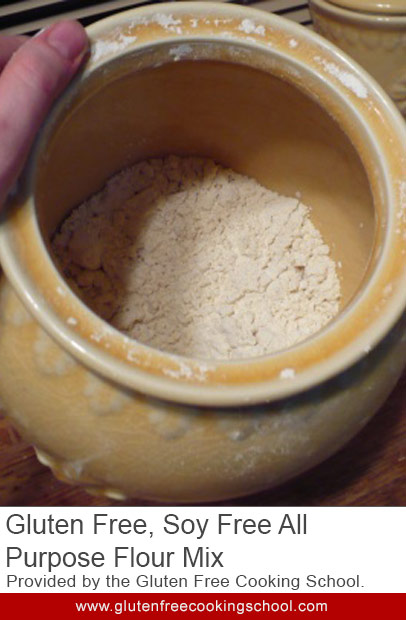Sometime in my early days of gluten free baking I learned two things: Gluten free baking takes longer than non-gluten free baking. And, I still have only 24 hours per day.
Conclusion:
If I’m ever going to get around to cleaning the kitchen or folding laundry, I need to reduce the amount of time allocated to gluten free baking.
I will admit that there is some hyperbole in that, but if you’ve ever had a similar thought, then gluten free flour mixes are for you.
If you’d like to learn more about why you have to use so many different flours together, what the flours do, and which gluten free flour mix is best for you, make sure to read my ebook, The Gluten Free Survival Guide. Several chapters are devoted to gluten free cooking, and you’ll get all of your questions answered there.
Flour Mix Options:
Store-bought gluten free bread mixes are the easiest. You just dump the dry ingredients and the wet ingredients into a bread machine and flip on the switch. If you’re like me though, you’ll run out of bread mix at the most opportune time and with gas for our car at $3.25 a gallon, I can’t justify running to the store for one bag of mix.
I’ve found that homemade flour mixes work the best for me. Years ago I made-up a recipe for an all-purpose Gluten Free All Purpose Flour mix that contains brown rice flour, cornstarch, soy flour, and masa harina. Both John and I like the taste and 3 of the ingredients are available locally at very inexpensive prices.
I mix up a big batch of this flour mix (usually 9 cups) every couple of weeks and store it in a air-tight container. Whenever I want to make a loaf of bread, biscuits, or pancakes I use my flour mix instead of having to measure out 3 or 4 different kinds of flours. If this sounds like something that would work for you, and you’re not allergic to soy or corn, then be sure to give it a try.
A New Flour Mix Recipe
Over the past few weeks, several of you have written to ask whether there is another ingredient that you can use instead of the soy flour. Soy is one of the 9 most common allergens and many of us that have issues with gluten also have issues with soy. Sorghum flour is used in many gluten free bread, so I’ve hesitantly suggested that to many of you.
Hesitantly, because I hadn’t tried it myself. I don’t like suggesting things that I haven’t tried myself, so I ordered sorghum flour from Bob’s Red Mill and made up a batch of flour mix. Thus far we have made sandwich bread, biscuits, and pancakes and all of them have turned out exceptionally well. I’m all out of sorghum flour now, so I’m going to give you the recipe and let you try out it too.
How to Use an All-Purpose Gluten Free Flour Mix
Just in case you’re new to this type of experiment, here are a few guidelines.
1. If you have a gluten free recipe that lists several types of flour, sum the amounts of each flours and substitute an equal amount of flour mix.
2. Check the recipe that you’re altering and make sure the ratio of flour:starch is about the same as in your flour mix. For instance the flour to starch ratio in my mixes is somewhere between 5:4 and 6:3. (The masa harina acts somewhat similarly to a starch – it absorbs a lot of water). If the recipe that you’re converting has a 3:4 flour to starch ratio, then the recipe author has added additional starch to “lighten” the recipe. If you are confident in your math abilities, then you can probably figure out how much additional starch to add. Otherwise, find another recipe for this type of experiment.
Instructions
- 3 parts brown rice flour
- 3 parts cornstarch
- 2 parts sorghum flour
- 1 part masa harina or corn flour
- Depending on how much mix you want to make, choose a measuring cup. If you want 9 cups of mix, use a 1 c. measure. If you just need a tad, you can use a 1/8 tsp. measure =)
- Whichever measure you choose is now a “part”. Scoop out the appropriate amounts of each flour and pour into a large mixing bowl.
- Sift/whisk/stir the flours until they are extremely well combined. No streaks of corn starch allowed.
- Store in an air-tight container in your pantry, refrigerator, or freezer depending on how long you think it will take you to use all of the mix. The colder the storage area, the longer the shelf life of the flours.

I have 2 small boys who require gfdfsf diets. The flour mix info is intriguing and I look foreword to trying it out! Breads, etc are their major comfort foods. Thanks!
I was wondering why the GF All Purpose Flour Mix requires brown rice flour? Is there a difference between the consistency of white rice and brown rice flour?
For those corn free people look up recipies with mostly Quinoa flour in them. I make a quinoa bread with Spelt flour or Sroghum flour and it tastes like cornbread. My neighbors didn’t believe that it wasn’t cornbread!!! you can buy quinoa and grind it or google quinoa flour if your local store doesn’t have it. Quinoa and Sorghum are GF but Spelt is not.